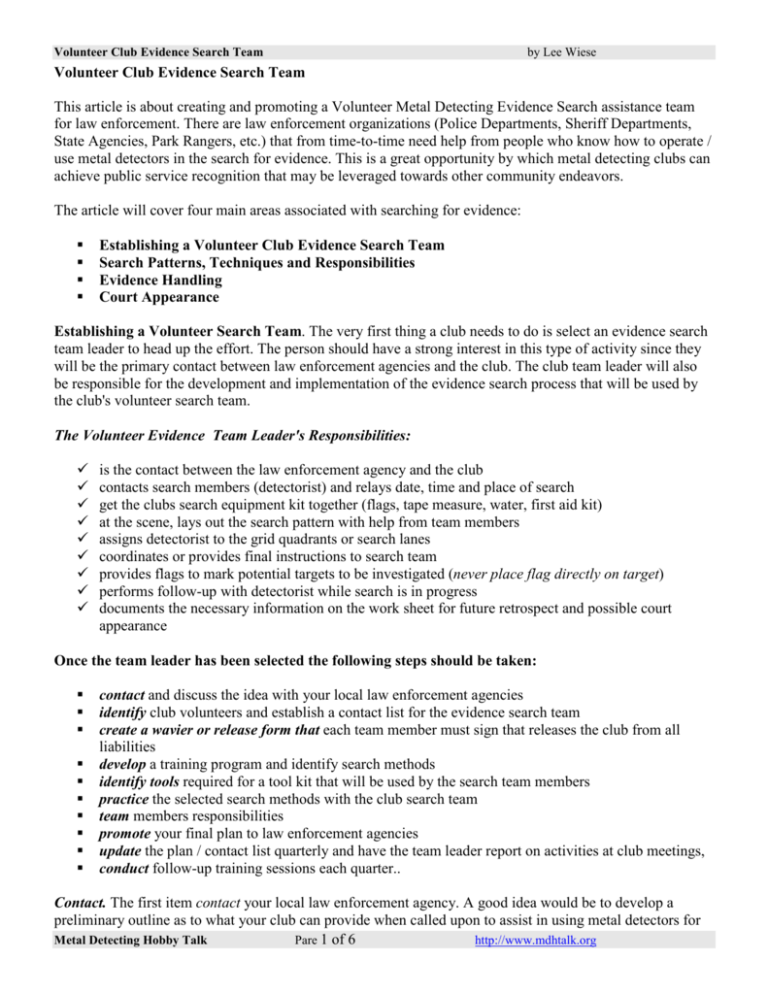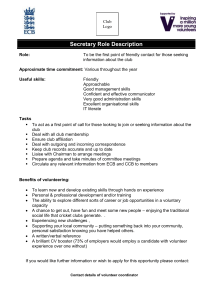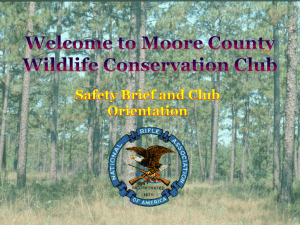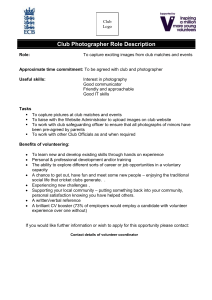Pare 1 of 6 Volunteer Club Evidence Search Team This article is
advertisement

Volunteer Club Evidence Search Team by Lee Wiese Volunteer Club Evidence Search Team This article is about creating and promoting a Volunteer Metal Detecting Evidence Search assistance team for law enforcement. There are law enforcement organizations (Police Departments, Sheriff Departments, State Agencies, Park Rangers, etc.) that from time-to-time need help from people who know how to operate / use metal detectors in the search for evidence. This is a great opportunity by which metal detecting clubs can achieve public service recognition that may be leveraged towards other community endeavors. The article will cover four main areas associated with searching for evidence: Establishing a Volunteer Club Evidence Search Team Search Patterns, Techniques and Responsibilities Evidence Handling Court Appearance Establishing a Volunteer Search Team. The very first thing a club needs to do is select an evidence search team leader to head up the effort. The person should have a strong interest in this type of activity since they will be the primary contact between law enforcement agencies and the club. The club team leader will also be responsible for the development and implementation of the evidence search process that will be used by the club's volunteer search team. The Volunteer Evidence Team Leader's Responsibilities: is the contact between the law enforcement agency and the club contacts search members (detectorist) and relays date, time and place of search get the clubs search equipment kit together (flags, tape measure, water, first aid kit) at the scene, lays out the search pattern with help from team members assigns detectorist to the grid quadrants or search lanes coordinates or provides final instructions to search team provides flags to mark potential targets to be investigated (never place flag directly on target) performs follow-up with detectorist while search is in progress documents the necessary information on the work sheet for future retrospect and possible court appearance Once the team leader has been selected the following steps should be taken: contact and discuss the idea with your local law enforcement agencies identify club volunteers and establish a contact list for the evidence search team create a wavier or release form that each team member must sign that releases the club from all liabilities develop a training program and identify search methods identify tools required for a tool kit that will be used by the search team members practice the selected search methods with the club search team team members responsibilities promote your final plan to law enforcement agencies update the plan / contact list quarterly and have the team leader report on activities at club meetings, conduct follow-up training sessions each quarter.. Contact. The first item contact your local law enforcement agency. A good idea would be to develop a preliminary outline as to what your club can provide when called upon to assist in using metal detectors for Metal Detecting Hobby Talk Pare 1 of 6 http://www.mdhtalk.org by Lee Wiese Volunteer Club Evidence Search Team an evidence search project. In your preliminary outline take a look at how many searchers you may have available and what the club’s reaction time for a request to assist would be. Make sure your law enforcement contact is involved in criminal matters and explore the club’s idea with them to get their reaction. Gather their thoughts on the subject, their level of interest and who the agency contact will be in the future. If you note a good degree of interest from the various agencies proceed to the next step. Identify. A very important next step in the club’s evidence recovery assistances plan is to identify club members that are interested in this public service. These members should have their own equipment, be familiar with target identification and be available on short notice. The list should be divided into three sections: those that can be available on very short notice (at least six persons) those that can be available to help but can not commit to short notice or a specific time period identify members capable of performing water searches develop a club release or waiver form (see PDF attachment for form) for each volunteer to sign Develop the training program. 1) Identify the most used metal detecting evidence search methods and techniques. Review the three patterns below. The Grid Search Pattern is probably the most common pattern to use while using metal detectors to search for evidence. This pattern should provide for complete coverage of any given search area. Metal detectorist are assigned a search quadrant in the grid. Dimensions of the grid & quadrants can vary based on the search area size that needs to be covered. This overlap search technique should be used to search each of the quadrants of the grid. The benefits are that each pass overlaps on the previous pass, leaving no undetected ground. Each detectorist must start in same quadrant location on the grid to minimize detector interference. To locate very small objects (i.e.: slugs) may require TWO passes in the same quadrant to ensure a thorough search. One pass in the vertical mode and the other pass in the horizontal mode (see examples in the above figure). Always overlap the search coil on each sweep of the coil. Metal Detecting Hobby Talk Pare 2 of 6 http://www.mdhtalk.org Volunteer Club Evidence Search Team by Lee Wiese The Lane Search Pattern requires that lanes be set up across the area to be searched. This pattern may be used where the search area is very long in length. The lanes should be set as wide as the detectorist coil swing and the detectorist must always overlap the search coil on each sweep of the coil. Each lane is to be assigned to one detectorist. The detectorist must start in a stagger fashion to minimize detector interference. Lanes should be clearly marked with Flags as to avoid missing any portion of the lane. It may be useful to outline the search area with crime scene tape. This will clearly establish the boundaries of the Lane Pattern Search Area. The Spiral Search Pattern is used mostly when conducting a search for objects in a small concentrated outdoor area. When using this method, the search detectorist will start at a designated central point of the scene and follow a spiral course outward from the central area until the perimeter is reached. The search area must be larger to cover the complete scene area since the search pattern is circular. Usually only one detectorist does the spiral search pattern and again coil sweep overlap is essential. 2) All evidence search team members should be trained in proper search methods (i.e.: detector swing speed, ground coverage or overlap, coil height, and detector setup.) 3) Create a set of worksheets for the team leader and search members to document their evidence search results. These notes are for possible future court appearances. (see PDF attachment for sample) 4) The recommended search method to use is a grid search pattern. Each club member should be assigned to a specific grid quadrant and reassigned once their quadrant of the grid has been searched reassignment takes place until the object is located. 5) Tools. It is also recommend that you go to a home supply store and purchase 150-200 colored Flags to outline / setup the search grid. Use the flags to highlight the grid quadrants on the ground being searched by using colored flag for each column and row. Other tools that maybe required are: tape measure, different color flags to identify possible located targets that will need to be research by the evidence recovery law enforcement staff. 6) The grid should be documented on paper with each searchers name and where the evidence or item was found. This may become important later if the data is required during a court proceeding. 7) The target recovery method to be used should be discussed before the search starts so as not to damage the evidence upon recovery. If the detectorist is to recovery the targeted item; the use of plastic tools and gloves would be required. Do not handle the evidence directly. Before you start also give consideration to having a similar sample of the evidence available so that members may calibrate / check their metal detector against the sample. (In most cases the detectorist will not recovery any targets.) 8) There should always be a law enforcement contact on site during any recovery assistance operation and follow their direction / input on recovery instructions. 9) Get a law enforcement agency to be part of the training course they can provide training and instruction on evidence handling and court appearances. (VERY INPORTANT) Once the method for searching has been selected, the club's volunteer search team needs to practice. Plant objects such as bullets, shell casing and other small objects in the grid. Assign searchers to the grid quadrants and began the practice session. Continue the practice session until each member has found the assigned objects in their quadrant of the grid. Use different objects for each practice search. Practice, Practice, Practice. Team Member Responsibilities: bring one or two discriminating detectors (if it’s a water search, the detector must be waterproof) bring water and food for at least six to eight hours of search time dress according to time of year and terrain to be searched (coats, boots, gloves, etc) use headphones and bring spare batteries Metal Detecting Hobby Talk Pare 3 of 6 http://www.mdhtalk.org by Lee Wiese Volunteer Club Evidence Search Team use the proper coil size which will depend on target size to be located and how trashy the area do not dig or use manual pin point tools like screw drivers, etc at a search scene (evidence to be recovered and removed by law enforcement staff only) overlap search coil swings for comprehensive search area coverage document the necessary information on a team work sheet for future retrospect and possible court appearance Promote your Evidence Recovery assistance team by creating a Volunteer Evidence Club Flyer or Club Brochure and personally distribute this Flyer or Brochure to your surrounding law enforcement agencies. Follow up with the agencies frequently so as to maintain visibility of the club program. Update your process quarterly, by verifying availability of search members, review experience gained from actual evidence searches and continue to practice the process with team members. Evidence Handling. The detectorist responsibility is to locate metallic evidence at a crime scene. A detectorist should never move, pickup or disturb any target located that might become crime scene evidences. A detectorist doing a search for evidence should not take photos of any type, measurement of the scene, or talk to any media staff or others without authorization from the law enforcement agencies handling the search scene. All targets located by a detectorist should be flagged at the scene and must be recovered by law enforcement evidence handling staff. Never place a flag on the target but somewhere within five inches or so of the pinpointed target. There are no exceptions on evidence handling unless law enforcement evidence handling staff authorize you to do otherwise. Court Appearance. The likely hood of having to provide testimony at a trial is fairly remote but the situation can occur. It is very important to take notes of any metal detecting crime scene search that you as a volunteer may take part. A few items to consider are: date, time, location, length of search time, weather conditions, quadrant assigned, detector used, detector program used, special detector adjustments, coil size, did you test your detector against a similar target before starting the search, notes on locating the target if you found it. The leader of your volunteer evidence search team should setup a uniform search document for you to record these items. Notes taken at the time of the search may become helpful to refresh your memory before a court appearance. If you are required to provide testimony you will be advised as to how to handle yourself, how to be specific with your answers, wear the appropriate courtroom attire and courtroom demeanor. Finally this type of club volunteer evidence search team can be very helpful to law enforcement, and rewarding to the individual members of the club. A Cautionary Note: Discussion about any evidence search to anyone outside of the law enforcement agency in charge MUST NEVER take place either before or after the search is complete. Metal Detecting Hobby Talk Pare 4 of 6 http://www.mdhtalk.org by Lee Wiese Volunteer Club Evidence Search Team Sample Waiver or Release Form Volunteer Evidence Search Team Club Name - Release / Waiver Form - Date I _______________________________ hereby apply for the Club Name Evidence Search Volunteer Team. I fully understand that whatever Volunteer Evidence Search Event I attend that I am fully responsible and at no time will have legal or financial claim against, nor hold responsible, any member or club officer of the Club Name for any equipment lost and damage, monetary compensation for mileage and time or bodily injuries that I may receive by my participation in any Volunteer Evidences Search Event. I will be responsible for my own equipment and actions and also agree to NOT hold the Club Name responsible in any way. By having read and signed this document I agreed to the above terms. Signed: ________________________________ Date: ________________ Time: ____________ Sample Check list and Search forms. Detectorist Check List before departing on a search Take Club Name Tag. Take one or two VLF detectors. Take head phones. Spare batteries. Appropriate attire for weather and terrain conditions. Food and water for six to twelve hours of search time. Spare medicine and pills. No recovery tools, cameras, side arms to be taken onto scene. Team Leader Check List Pickup grid and target ID flags. Tape measure to setup and measure the grid and quadrants. First Aid Kit. Blank forms for search documentation. All of the above for your personal use. Metal Detecting Hobby Talk Pare 5 of 6 http://www.mdhtalk.org Volunteer Club Evidence Search Team by Lee Wiese Team Leaders Worksheet Name of Search Scene: ____________________________________________ Date of Search: __________________________________________________ Time of Search: __________________________________________________ What is the item to be found: _______________________________________ Sample available to tune detectors: Yes or No Was Item found? Yes or No If Yes, quadrant number: _________________________________________ What was the item found: _________________________________________ Time item found: ________________________________________________ Grid or Lane Assignment: (members name) Q1a: ____________________________________ Q1b: ____________________________________ Q1c: ____________________________________ Q2a: ____________________________________ Q2b: ____________________________________ Q2c: ____________________________________ Q3a: ____________________________________ Q3b: ____________________________________ Q3c: ____________________________________ Q4a: ____________________________________ Q4b: ____________________________________ Q4c: ____________________________________ etc. Team Leaders Name: ____________________________________________ Leaders Signature: _______________________________________________ Team Member (Detectorist) Worksheet Wear Club Name Tag: Name of Search Scene: ______________________________________ Date of Search: _____________________________________________ Time of Search: _____________________________________________ Brand of Detector used: ______________________________________ Detector Program used: ______________________________________ Special Adjustments if any: ___________________________________ Quadrant Assigned: __________________________________________ Sample available to tune detector: Yes or No What is the item to be found: __________________________________ Was Item found? Yes or No Where found in the quadrant: _________________________________ Length of Time Searching: ____________________________________ Name of Detectorist: _________________________________________ Signature of Detectorist: _____________________________________ Metal Detecting Hobby Talk Pare 6 of 6 http://www.mdhtalk.org







